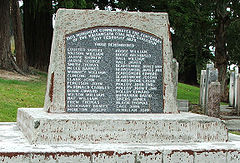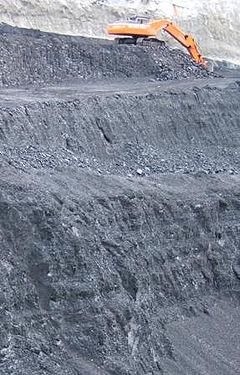
Kaitangata, New Zealand
Encyclopedia
Kaitangata is a town near the coast of South Otago
, New Zealand
, on the left bank of the Clutha River
ten kilometres south east of Balclutha
. The town is known to its residents simply as Kai.
The town sits close to the coast on one of the branches of the Clutha River
's delta. The small island of Inch Clutha
lies immediately to the southwest of the town. Close to the town to the north lies the small Lake Tuakitoto
, which drains into the Clutha via a small stream which runs to the west of Kaitangata.
According to the 2006 census
, the usually resident population of Kaitangata was 810, an increase of 21 since 2001. The town is largely of European descent, with well below the national average of people recorded as being non-European (7.1%).
The origin of the town's Māori
name is uncertain. It is the name of a figure in Polynesian
mythology, but could also refer to cannibal feasts held after tribal fighting in the district between Kāi Tahu
and Kāti Mamoe
. The name can be interpreted from Māori to English as, 'food for people' or 'people for food'.
 Kaitangata's European history is closely tied to coal
Kaitangata's European history is closely tied to coal
extraction. One of New Zealand's early industrial disaster
s occurred at the Kaitangata mine in 1879, when the lives of 34 miners were lost in an underground explosion.
Coal mining was the mainstay of the town's economy from the 1870s until 1972, when the last state-owned underground coal mine closed. Several open-cast mines have continued to exist (both state and private) up to the present day, such as the Kai Point Mine. The Kai Point Coal Company has been mining coal at Kaitangata since 1951 and produces coal for local industry and domestic heating. From 1876 to 1970, the Kaitangata Line
From 1876 to 1970, the Kaitangata Line
railway served the mines; initially privately owned, it later came into the state Mines Department's possession. The locomotive that operated the line for many years, known during operation as an "Improved F
", was donated to the preservation society at Shantytown
in Westland
and it operates heritage trains today with the nameplate "Kaitangata" in honour of its former home.
The underground mines produced sub-bituminous coal
of a high quality, which was used primarily as fuel for the steam locomotives, in use in NZ until the 1960s. When the railways switched to diesel locomotives the decline of underground mining occurred. The open-cast mines produce lignite
, which is primarily used in household fires. The continuing decline in the number of houses with coal fires, and the environmental push to replace the remaining fireplaces, means that the remaining open-cast mines days are numbered.
In recent years the town has gained some notoriety due to several high-profile crimes connected with the town (notably cases of arson in the 1990s). A local promotions society (formed from the former ratepayers' association) has improved this image somewhat and has been responsible for numerous civic projects in and around the town.
Famous Kaitangatans have included All Black rugby player Tony Brown.
South Otago
South Otago lies in the south east of the South Island of New Zealand. As the name suggests, it forms the southernmost part of the geographical region of Otago....
, New Zealand
New Zealand
New Zealand is an island country in the south-western Pacific Ocean comprising two main landmasses and numerous smaller islands. The country is situated some east of Australia across the Tasman Sea, and roughly south of the Pacific island nations of New Caledonia, Fiji, and Tonga...
, on the left bank of the Clutha River
Clutha River
The Clutha River / Mata-Au is the second longest river in New Zealand flowing south-southeast through Central and South Otago from Lake Wanaka in the Southern Alps to the Pacific Ocean, south west of Dunedin. It is the highest volume river in New Zealand, and the swiftest, with a catchment of ,...
ten kilometres south east of Balclutha
Balclutha, New Zealand
Balclutha is a town in Otago, it lies towards the end of the Clutha River on the east coast of the South Island of New Zealand. It is about halfway between Dunedin and Invercargill on the Main South Line railway, State Highway 1 and the Southern Scenic Route...
. The town is known to its residents simply as Kai.
The town sits close to the coast on one of the branches of the Clutha River
Clutha River
The Clutha River / Mata-Au is the second longest river in New Zealand flowing south-southeast through Central and South Otago from Lake Wanaka in the Southern Alps to the Pacific Ocean, south west of Dunedin. It is the highest volume river in New Zealand, and the swiftest, with a catchment of ,...
's delta. The small island of Inch Clutha
Inch Clutha
Inch Clutha is a large, flat island sitting in the delta between the Matau and Koau branches of the Clutha River, downstream from the town of Balclutha in the South Island of New Zealand...
lies immediately to the southwest of the town. Close to the town to the north lies the small Lake Tuakitoto
Lake Tuakitoto
Lake Tuakitoto is a small lake in South Otago, in the South Island of New Zealand. It is located to the northeast of Balclutha, close to the small town of Kaitangata. The smallest of South Otago's three main lakes, it is, like the others very shallow. The lake drains into the lower reaches of the...
, which drains into the Clutha via a small stream which runs to the west of Kaitangata.
According to the 2006 census
New Zealand Census of Population and Dwellings
The New Zealand government department Statistics New Zealand conducts a census of population and dwellings every five years. The census scheduled for 2011 was cancelled due to circumstances surrounding the February 2011 Christchurch earthquake, however, and legislation introduced to hold the next...
, the usually resident population of Kaitangata was 810, an increase of 21 since 2001. The town is largely of European descent, with well below the national average of people recorded as being non-European (7.1%).
The origin of the town's Māori
Maori language
Māori or te reo Māori , commonly te reo , is the language of the indigenous population of New Zealand, the Māori. It has the status of an official language in New Zealand...
name is uncertain. It is the name of a figure in Polynesian
Polynesian culture
Polynesian culture refers to the indigenous peoples' culture of Polynesia who share common traits in language, customs and society. Chronologically, the development of Polynesian culture can be divided into four different historical eras:...
mythology, but could also refer to cannibal feasts held after tribal fighting in the district between Kāi Tahu
Ngai Tahu
Ngāi Tahu, or Kāi Tahu, is the principal Māori iwi of the southern region of New Zealand, with the tribal authority, Te Rūnanga o Ngāi Tahu, being based in Christchurch and Invercargill. The iwi combines three groups, Kāi Tahu itself, and Waitaha and Kāti Mamoe who lived in the South Island prior...
and Kāti Mamoe
Kati Mamoe
Kāti Mamoe, or Ngāti Mamoe, is an historic Māori iwi. Originally from the Heretaunga area they moved in the 16th century to the South Island which at the time was occupied by Waitaha....
. The name can be interpreted from Māori to English as, 'food for people' or 'people for food'.

Coal
Coal is a combustible black or brownish-black sedimentary rock usually occurring in rock strata in layers or veins called coal beds or coal seams. The harder forms, such as anthracite coal, can be regarded as metamorphic rock because of later exposure to elevated temperature and pressure...
extraction. One of New Zealand's early industrial disaster
Disaster
A disaster is a natural or man-made hazard that has come to fruition, resulting in an event of substantial extent causing significant physical damage or destruction, loss of life, or drastic change to the environment...
s occurred at the Kaitangata mine in 1879, when the lives of 34 miners were lost in an underground explosion.
Coal mining was the mainstay of the town's economy from the 1870s until 1972, when the last state-owned underground coal mine closed. Several open-cast mines have continued to exist (both state and private) up to the present day, such as the Kai Point Mine. The Kai Point Coal Company has been mining coal at Kaitangata since 1951 and produces coal for local industry and domestic heating.

Kaitangata Line
The Kaitangata Line, also known as the Kaitangata Branch in its first years of operation, was a railway line in Otago, New Zealand. It was built by a private company and was later acquired by the government's Mines Department, and operated from 1876 until 1970...
railway served the mines; initially privately owned, it later came into the state Mines Department's possession. The locomotive that operated the line for many years, known during operation as an "Improved F
NZR F class
The NZR F class was the first important class of steam locomotive built to operate on New Zealand's railway network after the national gauge of 1067 millimetres was adopted. The first locomotives built for the new 1067 mm railways were two E class double Fairlies for the Dunedin and Port Chalmers...
", was donated to the preservation society at Shantytown
Shantytown, New Zealand
Shantytown is a tourist attraction in the West Coast Region of the South Island of New Zealand. Located ten kilometres south of Greymouth, the town was constructed and opened in the early 1970s and consists of some thirty re-created historic buildings making up a 19th century gold-mining town...
in Westland
West Coast, New Zealand
The West Coast is one of the administrative regions of New Zealand, located on the west coast of the South Island, and is one of the more remote and most sparsely populated areas of the country. It is made up of three districts: Buller, Grey and Westland...
and it operates heritage trains today with the nameplate "Kaitangata" in honour of its former home.
The underground mines produced sub-bituminous coal
Sub-bituminous coal
Sub-bituminous coal is a type of coal whose properties range from those of lignite to those of bituminous coal and are used primarily as fuel for steam-electric power generation.- Properties:...
of a high quality, which was used primarily as fuel for the steam locomotives, in use in NZ until the 1960s. When the railways switched to diesel locomotives the decline of underground mining occurred. The open-cast mines produce lignite
Lignite
Lignite, often referred to as brown coal, or Rosebud coal by Northern Pacific Railroad,is a soft brown fuel with characteristics that put it somewhere between coal and peat...
, which is primarily used in household fires. The continuing decline in the number of houses with coal fires, and the environmental push to replace the remaining fireplaces, means that the remaining open-cast mines days are numbered.
In recent years the town has gained some notoriety due to several high-profile crimes connected with the town (notably cases of arson in the 1990s). A local promotions society (formed from the former ratepayers' association) has improved this image somewhat and has been responsible for numerous civic projects in and around the town.
Famous Kaitangatans have included All Black rugby player Tony Brown.
External links
- www.kaitangatablackgold.co.nz
- KAITANGATA MINE DISASTER - 21 FEBRUARY 1879
- Kai Point Coal Mine website

